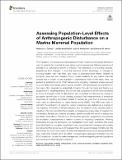Files in this item
Assessing population-level effects of anthropogenic disturbance on a marine mammal population
Item metadata
| dc.contributor.author | Dunlop, Rebecca A | |
| dc.contributor.author | Braithwaite, Janelle | |
| dc.contributor.author | Mortensen, Lars O | |
| dc.contributor.author | Harris, Catriona M | |
| dc.date.accessioned | 2021-03-17T13:30:06Z | |
| dc.date.available | 2021-03-17T13:30:06Z | |
| dc.date.issued | 2021-03-15 | |
| dc.identifier | 273096202 | |
| dc.identifier | bb812ae9-de98-4a35-868a-90eeb76571ad | |
| dc.identifier | 85103420116 | |
| dc.identifier | 000630755900001 | |
| dc.identifier.citation | Dunlop , R A , Braithwaite , J , Mortensen , L O & Harris , C M 2021 , ' Assessing population-level effects of anthropogenic disturbance on a marine mammal population ' , Frontiers in Marine Science , vol. 8 , 624981 . https://doi.org/10.3389/fmars.2021.624981 | en |
| dc.identifier.issn | 2296-7745 | |
| dc.identifier.other | ORCID: /0000-0001-9198-2414/work/90951887 | |
| dc.identifier.uri | https://hdl.handle.net/10023/21645 | |
| dc.description | The authors declare that this study received funding from the Joint Industry Programme on E&P Sound and Marine Life (JIP), managed by the International Association of Oil & Gas Producers (IOGP). The principal contributing companies to the programme are BG group, BHP Billiton, Chevron, ConocoPhillips, Eni, ExxonMobil, IAGC, Santos, Statoil and Woodside, The United States Bureau of Ocean Energy Management (BOEM), Origin Energy, Beach Energy and AWE. The Australian Commonwealth Department of the Environment and the Redland City Council (RCC) for provided funding for the east coast Australian humpback whale population surveys. Funding for CH’s involvement was supported by U.S. Office of Naval Research grant N00014-16-1-2858: “PCoD+: Developing widely applicable models of the population consequences of disturbance”. | en |
| dc.description.abstract | The Population Consequences of Disturbance (PCoD) model is a conceptual framework used to assess the potential for population-level consequences following exposure of animals to a disturbance activity or stressor. This framework is a four-step process, progressing from changes in individual behavior and/or physiology, to changes in individual health, then vital rates, and finally to population-level effects. Despite its simplicity, there are few complete PCoD models available for any marine mammal species due to a lack of data available to parameterize many of the steps. Here, we present an application of the PCoD framework for migrating humpback whales exposed to a simulated commercial seismic survey scenario. We approached the framework in two ways; first, progressing sequentially forwards through the steps and basing our assessment on lactating females. This cohort was considered to be the most vulnerable in terms of energetic costs of disturbance, and most likely to influence any change in population growth due to future breeding success. Field measurements of behavioral responses of migrating humpback whales to seismic air guns from a previous study were used to parameterize an agent-based model (ABM). This ABM was used to estimate the probability of response, where a response was defined as a change in the migratory movement of female-calf pairs, and the duration of any resulting delay in migration. We then estimated the energetic consequences of any delay in migration for the lactating females and created population growth models with which to assess any population-level effects. The results of the forwards approach suggested a low potential for population consequences of seismic surveys on migrating humpbacks. Working backwards through the framework, we investigated ‘worst case’ scenario(s) that could potentially lead to a population-level effect. Here, we started with increasing calf mortality and assumed that an exposure time greater than 48 hours would increase mortality risk. We determined the most likely context in which this exposure would occur (resting area) and then tested this context within an ABM. This backwards approach illustrates how the PCoD model can be used to make management decisions regarding animal populations and exposure to anthropogenic stressors. | |
| dc.format.extent | 12 | |
| dc.format.extent | 1154900 | |
| dc.language.iso | eng | |
| dc.relation.ispartof | Frontiers in Marine Science | en |
| dc.subject | Agent-based modeling | en |
| dc.subject | Anthropogenic activity | en |
| dc.subject | Behavioral response | en |
| dc.subject | Energetics | en |
| dc.subject | Humpback whale | en |
| dc.subject | Ocean noise | en |
| dc.subject | PCOD | en |
| dc.subject | Seismic survey | en |
| dc.subject | GC Oceanography | en |
| dc.subject | QH301 Biology | en |
| dc.subject | NDAS | en |
| dc.subject | SDG 14 - Life Below Water | en |
| dc.subject.lcc | GC | en |
| dc.subject.lcc | QH301 | en |
| dc.title | Assessing population-level effects of anthropogenic disturbance on a marine mammal population | en |
| dc.type | Journal article | en |
| dc.contributor.institution | University of St Andrews. School of Biology | en |
| dc.contributor.institution | University of St Andrews. Scottish Oceans Institute | en |
| dc.contributor.institution | University of St Andrews. Centre for Research into Ecological & Environmental Modelling | en |
| dc.contributor.institution | University of St Andrews. Sea Mammal Research Unit | en |
| dc.contributor.institution | University of St Andrews. Office of the Principal | en |
| dc.identifier.doi | 10.3389/fmars.2021.624981 | |
| dc.description.status | Peer reviewed | en |
This item appears in the following Collection(s)
Items in the St Andrews Research Repository are protected by copyright, with all rights reserved, unless otherwise indicated.

